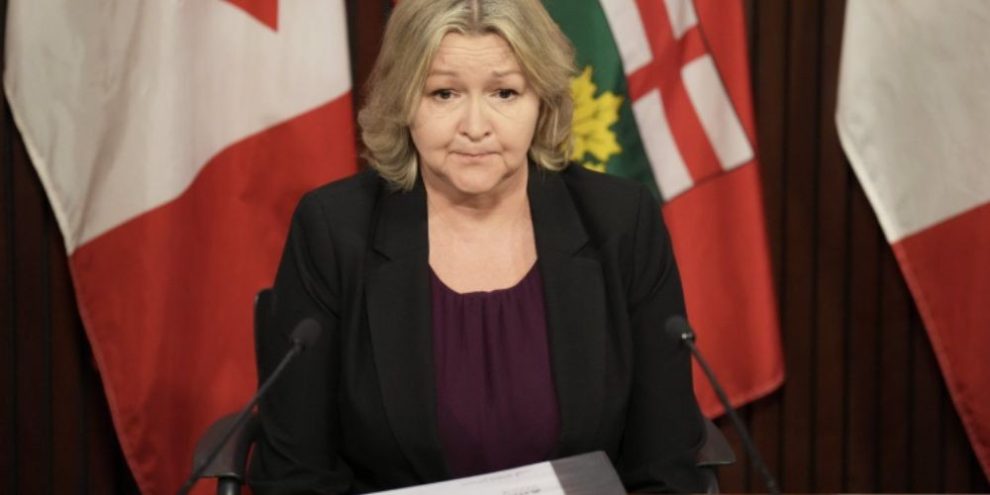
Updated October 1, 2025 @ 4:36pm
Ontario is not on track to meet its targets on child-care fees, the number of spaces created or the percentage of qualified staff within the $10-a-day system, the province's auditor general has found.
Shelley Spence's office released a report Wednesday looking at Ontario's progress in implementing the national child-care program and found that while several provinces have already lowered parent fees to an average of $10 a day, Ontario likely won't meet that unless it makes some changes.
"The $10 a day is achievable, but the next day it may be a problem," Spence said at a press conference.
While Ontario has an agreement-in-principle with the federal government saying that it wants to extend the program beyond the current term that expires on March 31, 2026, it has not yet signed a deal to continue delivering the reduced parental fees.
Officials have said that the current federal funding would leave the province short $2 billion next year.
Ontario, which had the highest daycare fees in the country, has spent the federal government's five-year funding over four years, Spence wrote.
"If you start with the highest costs then you do take the funding and use it in four years instead of five, which is what it was given for, you can automatically see why you'd have that $1.95-billion deficit the next year," she said Wednesday.
Education Minister Paul Calandra said that was essentially an accounting issue, but the upcoming funding shortfall still looms.
"I don't think, frankly, that we will be in a position to meet the $10-a-day program as set up by the federal government, unless they are willing to step up to the plate and add the money that is required to get us to $10 a day," he said.
Barrie's News Delivered To Your Inbox
By submitting this form, you are consenting to receive marketing emails from: Central Ontario Broadcasting, 431 Huronia Rd, Barrie, Ontario, CA, https://www.cobroadcasting.com. You can revoke your consent to receive emails at any time by using the SafeUnsubscribe® link, found at the bottom of every email. Emails are serviced by Constant Contact
Negotiations have not yet started, though, Calandra said.
"I know that they have a challenge with their budget not coming until the fourth of November, but we've got to get moving, and we will get to the table with them. I don't think they're obfuscating. ... They've just had a lot of other things that they've been focused on. But I think parents are also focused on a lot of things, and they want some certainty."
If parents were to end up footing the bill for the shortfall they would end up paying $32 a day, on average, come April 1, the auditor said.
Fees are currently capped at $22 a day, down from an average of $48 a day before the program began in Ontario. Those lowered fees created additional demand for licensed child care and have meant that lower-income families are losing out, Spence found.
In addition to the national $10-a-day program, low-income families can get further fee subsidies on a sliding scale, such that parents earning $20,000 or less pay nothing. However, compared to 2019, there has been a 31 per cent decrease in the enrolment of children receiving fee subsidies, the auditor found.
Child-care wait lists have also risen sharply since the program began, the auditor wrote, but the government doesn't collect data to understand demand.
The province has also not been creating enough new spaces to meet its targets, she found.
When Ontario signed the child-care deal with the federal government in 2022, it agreed to create 86,000 new spaces within the system by December 2026, which the financial accountability officer has said would still leave the province short of meeting demand for more than 220,000 spots.
The province only achieved about 75 per cent of its interim space creation target at the end of 2024, Spence found.
Last fall, the government reworked the way it assigned space creation targets in different regions of the province – instead of focusing on areas most in need of new spaces, it focused on areas that could more quickly create spaces, so Ontario had a better shot at meeting its overall target, the auditor said.
"Through this new approach, the ministry aims to better achieve its commitment of adding 86,000 net new spaces, but these spaces may not be in the regions with highest need," she wrote.
As well, while the number of registered early childhood educators in the system has increased, it's still below the province's target, and while the government estimated in 2022 that it would need 8,500 more ECEs by 2026, the auditor said that has now risen to 10,000.
The auditor found that about 27 per cent of the spaces within the $10-a-day program in Ontario are not actually in use. Child-care operators have said one of the biggest challenges in creating new spaces and maintaining existing ones is staff shortages.
The executive director of the Association of Early Childhood Educators Ontario said the report should be a wake-up call for Ontario to improve wages, benefits and pensions for the child-care workforce.
"We won't improve access to child care until we improve decent work and pay for those providing the care," Amber Straker wrote in a statement.
This report by The Canadian Press was first published Oct. 1, 2025.





